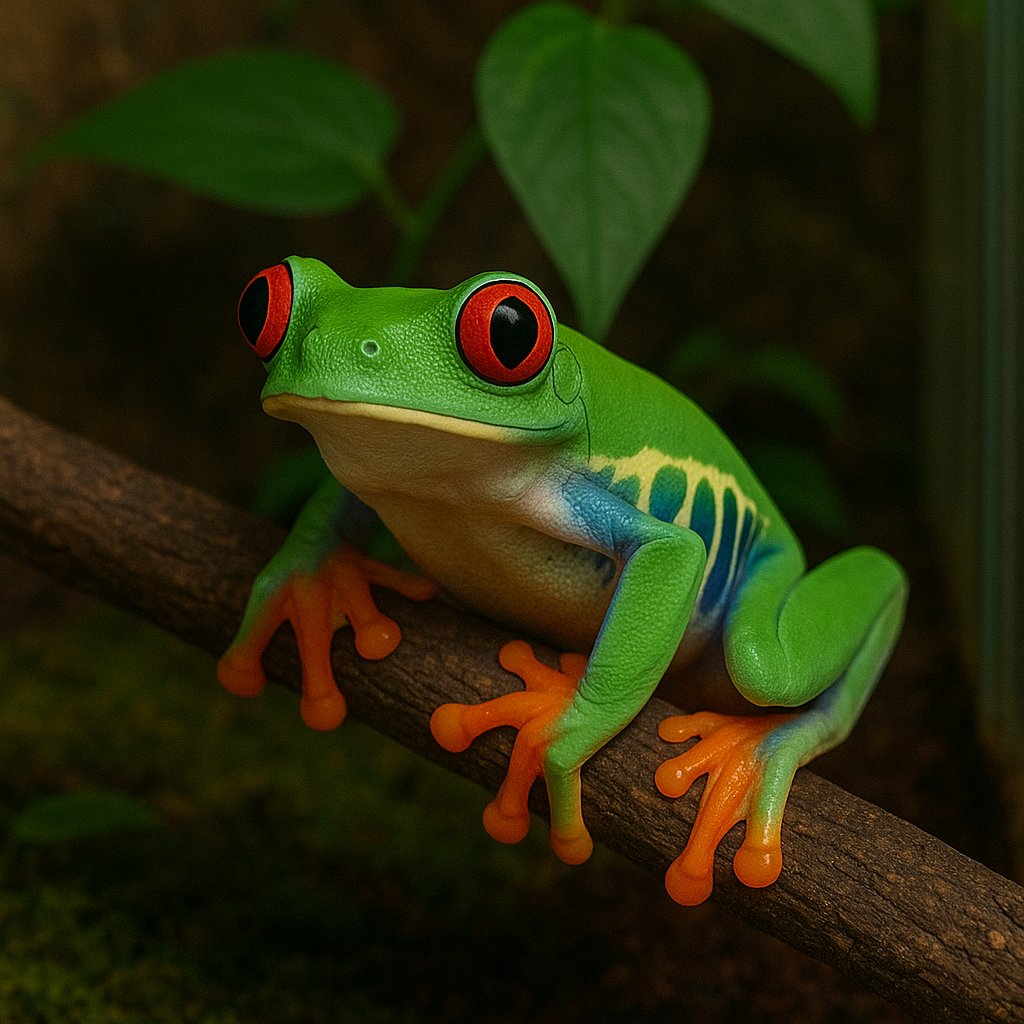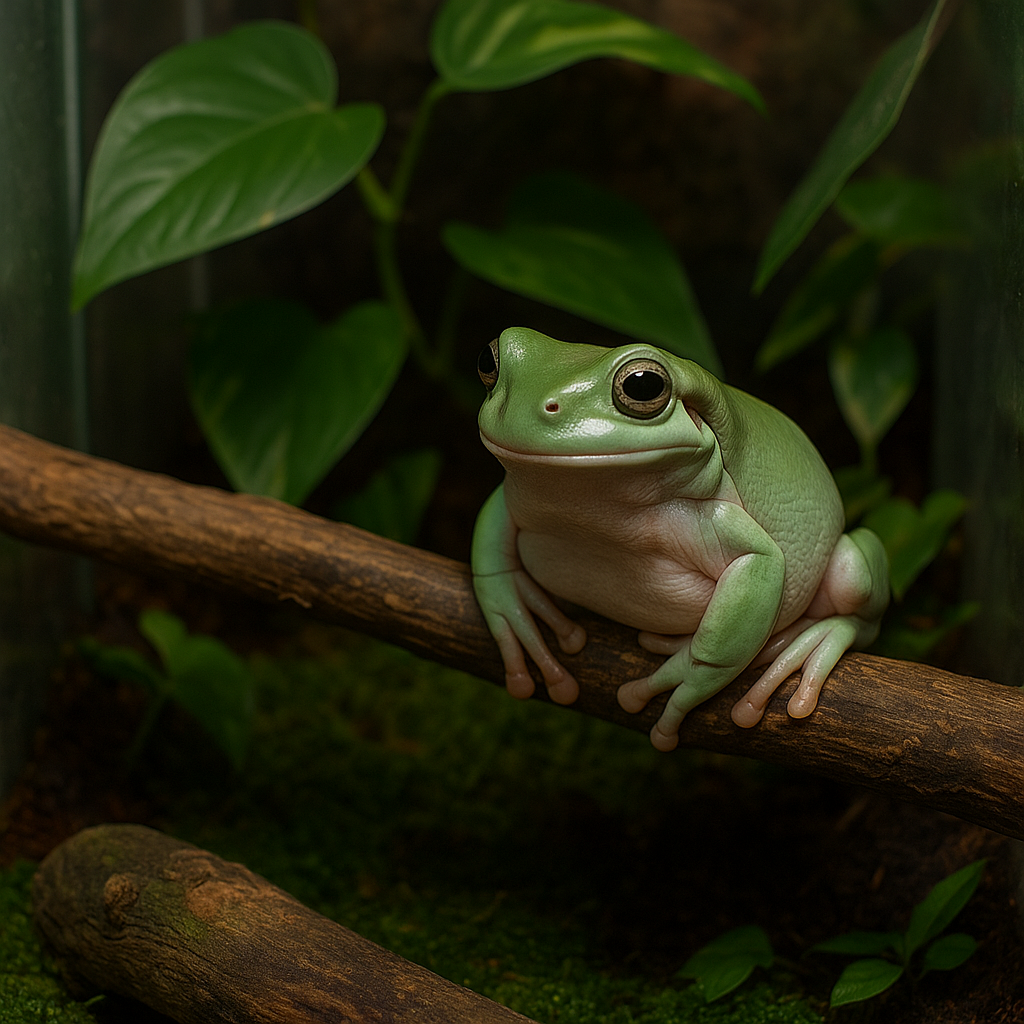Keeping dart frogs is addictive—bright colours, fascinating behaviours, and the thrill of a rainforest right in your living room. But there’s one common frustration: you never see them. They seem to vanish into the leaves, behind the wood, under the bromeliads.
Some people even search for “bald frog” thinking their frogs must be shedding or missing something, when in fact what they’re experiencing is completely normal: frogs hiding all day long.
The good news? You can encourage your frogs to be bolder and more visible by setting up their vivarium correctly. Let’s explore why dart frogs (and other tropical amphibians) hide, what their behaviour tells you, and how to create a habitat where you’ll actually see them.
Why Dart Frogs Hide in the Wild
To understand your frog at home, you have to think about its natural rainforest habitat. Dart frogs are mostly forest floor dwellers. In the wild:
- They live under a thick canopy of trees, meaning light is filtered and dappled.
- The floor is dense with leaf litter, roots, mosses, and fallen wood.
- Frogs spend much of their time foraging in and out of cover, rather than basking in the open.
So when you put a dart frog in a brightly lit vivarium with bare substrate and a couple of plastic plants, it does the only thing it knows how to do: it hides.
Common Reasons Frogs Stay Hidden
Here are the top reasons dart frogs and other tropical frogs stay out of sight:
1. Too Much Light
Frogs don’t like to be exposed under intense lighting. In the rainforest they would rarely, if ever, experience direct sunlight.
- Use LED plant lights with a natural spectrum but make sure they are softened by tall plants or canopy cover.
- Avoid blasting the vivarium with unfiltered light.
2. Not Enough Plants
Bare vivariums make frogs nervous. They want to move through cover, not across open ground.
- Add broad-leafed plants, ferns, bromeliads, and mosses.
- Plant heavily—more is always better.
3. Lack of Hides
If your frogs don’t feel secure, they won’t explore.
- Provide cork bark, coconut huts, and leaf litter.
- Think in layers: canopy, mid-level foliage, and plenty of low hides.
4. Temperature is Too Low
Dart frogs are most active between 22–26°C. Below this range, they slow down.
- Use a thermometer at both ends of the vivarium.
- A small rise in temperature within the safe range often brings them out to forage.
5. Humidity Drops
If the vivarium dries out, frogs retreat into moist retreats.
- Mist regularly or install an automated misting system.
- Monitor with a hygrometer; aim for 70–100% humidity depending on species.
6. Stress
Stress from handling, new environments, or loud disturbances makes frogs hide.
- Give them time to settle after moving them.
- Keep the vivarium in a low-traffic area of your home.
How to Make Frogs More Visible in a Vivarium
Visibility is about designing a vivarium that balances frog security with human viewing pleasure.
- Plant densely at the back and sides, and leave the front more open. This way frogs feel hidden while still being visible to you.
- Use bromeliads, coconuts, and vines to create “frog highways” that bring them into the open naturally.
- Offer microhabitats: a mix of wet mossy patches, drier leaf litter, and climbing areas.
- Feed in visible areas. Place fruit flies and springtails near the front; frogs learn where to hunt.
Tip: Many keepers report that frogs become bolder once they realise food appears near the viewing glass.
Are Some Species More Visible Than Others?
Yes. Some dart frog species are naturally bolder, while others are secretive.
- Bolder species: Dendrobates tinctorius morphs (like Azureus, Patricia, Citronella), D. leucomelas, Phyllobates terribilis.
- Shy species: Many Ranitomeya (thumbnail frogs) and Oophaga pumilio morphs.
If you want “pet frogs you can see all the time,” stick with larger Dendrobates or Phyllobates.
FAQ Section
Here are some of the most asked questions about frogs hiding, with answers written for quick Google pickup.
Why is my frog hiding all the time?
Because in the wild, dart frogs live under forest cover. If your vivarium is too bright, bare, or lacks hiding places, they will retreat.
Do dart frogs need hides?
Yes. They feel secure only when they can retreat into cover. Without hides, they will stay stressed and out of sight.
What temperature makes dart frogs active?
Most dart frogs are most active between 22–26°C. Below this, they slow down and may hide more often.
Will my frogs come out more at night?
Dart frogs are diurnal (day-active). If they’re only moving at night, check your lighting, temperature, and planting.
Can you make dart frogs tame?
They don’t tame in the way reptiles do, but they can become bolder if they associate you with food and their environment feels safe.
Is it normal never to see my frogs?
It’s common, especially with shy species. But with the right setup, you should see them hunting, climbing, and calling during the day.
Example Setup for Bold Frogs
Imagine you want your frogs front and centre. Here’s a proven formula:
- Tank size: At least 45×45×45 cm for a small group of Dendrobates tinctorius.
- Lighting: LED full spectrum, but filtered through tall plants.
- Substrate: Bioactive (ABG mix, drainage layer, leaf litter).
- Plants: Heavy planting with broad leaves and vertical elements.
- Microfauna: Springtails and isopods to clean waste.
- Temperature: Stable 23–25°C.
- Feeding: Fruit flies dusted with calcium and vitamins, released at the front.
Result? Frogs that move in and out of cover, often visible at eye level.
The Balance Between Natural Behaviour and Human Enjoyment
It’s worth remembering: hiding is natural. Frogs that feel comfortable enough to show themselves are a sign of good husbandry, but you’ll never have a frog that poses like a fish in an aquarium.
Instead, design your vivarium with naturalism in mind. You’ll not only see your frogs more often but also get the pleasure of watching them behave as they would in the rainforest—darting between bromeliads, wrestling over food, and calling to each other.
Final Thoughts
If you’ve been worried because your dart frogs never show themselves, you’re not alone. Almost every keeper goes through this stage. But once you adjust lighting, planting, hides, and temperature, you’ll be amazed at how much more visible your frogs become.
The rainforest is dense, complex, and alive. Bring that into your vivarium, and your frogs will reward you with activity, colour, and behaviour that makes them a joy to watch.



